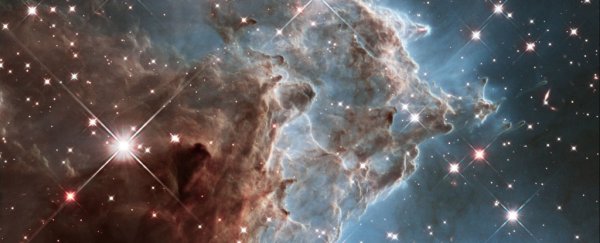It's 2021, and we finally don't have to worry quite so much about our spacecraft getting lost in interstellar space.
Using the positions and shifting light of stars, both near and far, astronomer Coryn A.L. Bailer-Jones has demonstrated the feasibility of autonomous, on-the-fly navigation for spacecraft traveling far beyond the Solar System.
Interstellar space navigation may not seem like an immediate problem. However, already in the last decade human-made instruments have entered interstellar space, as first Voyager 1 (in 2012) and Voyager 2 (in 2018) crossed the Solar System boundary known as the heliopause.
It's only a matter of time before New Horizons joins them, followed by more probes in the future. As these spacecraft travel farther and farther from their home planet, communication with Earth takes longer and longer.
New Horizons is currently nearly 14 light-hours from Earth, which means it takes 28 hours to send a signal and receive a response; not an impossible tracking and navigation system, but an ungainly one.
At greater and greater distances, however, this will no longer be reliable.
"When travelling to the nearest stars, signals will be far too weak and light travel times will be of order years," Bailer-Jones wrote in his paper, which is currently available on the preprint server arXiv, where it awaits peer review from the astronomy community.
"An interstellar spacecraft will therefore have to navigate autonomously, and use this information to decide when to make course corrections or to switch on instruments. Such a spacecraft needs to be able to determine its position and velocity using only onboard measurements."
Bailer-Jones, who works at the Max Planck Institute for Astronomy in Germany, isn't the first to think of this. NASA has been working on navigation by pulsars, using the dead stars' regular pulsations as the basis for a galactic GPS. This method sounds pretty great, but it may be subject to errors at greater distances, due to distortion of the signal by the interstellar medium.
With a catalog of stars, Bailer-Jones was able to show that it's possible to work out a spacecraft's coordinates in six dimensions - three in space and three in velocity - to a high accuracy, based on the way the positions of those stars changes from the spacecraft's point of view.
"As a spacecraft moves away from the Sun, the observed positions and velocities of the stars will change relative to those in a Earth-based catalog due to parallax, aberration, and the Doppler effect," he wrote.
"By measuring just the angular distances between pairs of stars, and comparing these to the catalog, we can infer the coordinates of the spacecraft via an iterative forward-modelling process."
Parallax and aberration both refer to the apparent change in the positions of stars due to Earth's motion. The Doppler effect is the change in the wavelength of light from a star based on whether it appears to be moving closer to or away from the observer.
Because all of these effects involve the relative positions of the two bodies, a third body (the spacecraft) in a different position will see a different arrangement of the stars.
It's actually pretty difficult to determine the distances to stars, but we're getting a lot better. The Gaia satellite is conducting an ongoing mission to map the Milky Way in three dimensions, and has given us the most accurate map of the galaxy to date.
Bailer-Jones tested his system using a simulated star catalog, and then on nearby stars from the Hipparcos catalog compiled in 1997, at relativistic spacecraft speeds. Although this is not as accurate as Gaia, that's not terribly important - the aim was to test that the navigation system can work.
With just 20 stars, the system can determine the position and velocity of a spacecraft to within 3 astronomical units and 2 kilometers per second (1.24 miles per second). This accuracy can be improved inverse to the square root of the number of stars; with 100 stars, the accuracy came down to 1.3 astronomical units and 0.7 kilometers per second.
There are some kinks that would need to be worked out. The system hasn't taken stellar binaries into consideration, nor has it considered the instrumentation. The aim was to show that it could be done, as a first step towards actualizing it.
It's even possible that it could be used in tandem with pulsar navigation so that the two systems might be able to minimize each other's flaws. And then the sky, literally, is the limit.
The paper is available on arXiv.
